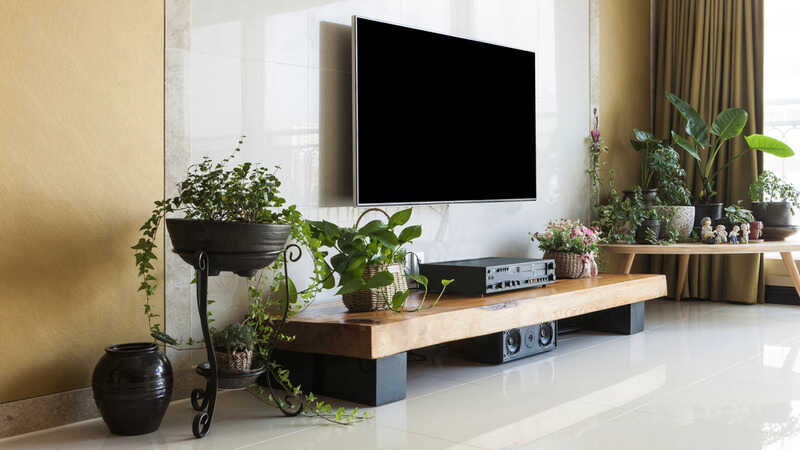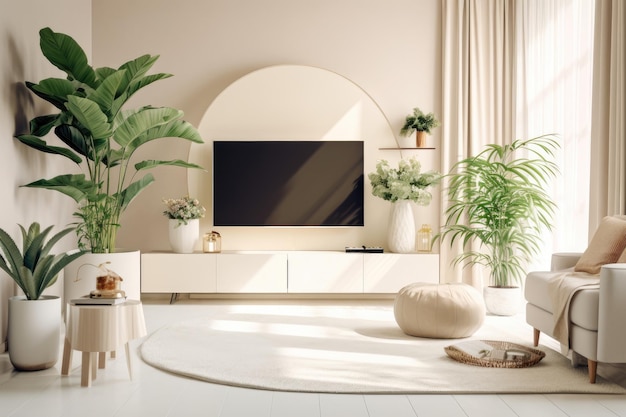10 Ways to Add Plants to Your TV Wall for a Natural Look
10 Ways to Add Plants to Your TV Wall for a Natural Look

Introduction
Your TV wall is a blank canvas that can be used to create a stunning focal point in your living room. But if you're tired of the same old boring look, why not add some plants? Plants can add a touch of nature to your space, improve air quality, and even help to reduce stress.
In this blog post, we'll share 10 ways to add plants to your TV wall for a natural look. We'll cover everything from choosing the right plants to styling them in a way that complements your existing décor. So whether you're a seasoned plant parent or you're just starting out, read on for some inspiration!


1. Choose the Right Plants

The first step to adding plants to your TV wall is choosing the right plants. There are a few things to keep in mind when making your selection.
- The size of your TV wall: If you have a large TV wall, you can get away with using larger plants. If you have a smaller TV wall, you'll need to choose smaller plants.
- The amount of light your TV wall gets: Some plants need a lot of light, while others can tolerate low light conditions. Make sure to choose plants that will thrive in the conditions that your TV wall receives.
- Your personal style: When choosing plants, think about your personal style and what you want your TV wall to look like. Do you want a lush, tropical look? A minimalist, modern look? Or something in between?


Once you've considered these factors, you can start choosing plants for your TV wall. Here are a few of our favorites:

- Philodendrons: Philodendrons are a great option for beginners because they're easy to care for and tolerant of a wide range of conditions. They come in a variety of sizes and shapes, so you can find one that's perfect for your TV wall.
- Pothos: Pothos are another great option for beginners. They're also easy to care for and tolerant of low light conditions. Pothos come in a variety of variegated colors, so you can add a pop of color to your TV wall.
- Sansevierias: Sansevierias, also known as snake plants, are very low-maintenance plants that can tolerate neglect. They're also very tolerant of a wide range of conditions, making them a great option for beginners.
- ZZ plants: ZZ plants are another great option for beginners. They're very tolerant of neglect and a wide range of conditions. ZZ plants are also very slow-growing, so they won't outgrow your TV wall anytime soon.
2. Style Your Plants


Once you've chosen your plants, it's time to style them in a way that complements your existing décor. Here are a few tips:

- Group your plants together: Grouping your plants together will create a more cohesive look. You can group plants by size, shape, or color.
- Use different heights and textures: Mixing different heights and textures will add interest to your TV wall. You can use tall plants, short plants, and trailing plants.
- Add some accessories: Adding some accessories to your TV wall will help to tie the whole look together. You can add pots, planters, or even some decorative objects.
Here are a few examples of how you can style your plants on your TV wall:


- A grouping of different-sized philodendrons in a variety of pots on a shelf above the TV.
- A tall snake plant in a planter next to the TV.
- A hanging ZZ plant in front of the TV.
- A grouping of trailing pothos plants on a shelf below the TV.

3. Hang Plants on the Wall
If you don't have a lot of space on your TV wall, you can hang plants on the wall. There are a few different ways to do this.


- Use a wall-mounted planter: A wall-mounted planter is a great way to display a single plant. You can find wall-mounted planters in a variety of styles, so you can find one that fits your décor.
- Use a hanging planter: A hanging planter is a great way to display a trailing plant. You can find hanging planters in a variety of shapes and sizes, so you can find one that fits your TV wall.
- Use a macrame hanger: A macrame hanger is a great way to display a variety of plants. You can use a macrame hanger to create a vertical garden on your TV wall
10 Ways to Add Plants to Your TV Wall
Introduction

Your TV wall is a blank canvas that can be used to create a stunning focal point in your living room. If you're looking to add some greenery to your space, consider adding plants to your TV wall. Plants can add a touch of nature to your home, improve air quality, and create a more relaxing atmosphere.
In this article, we'll share 10 ideas for adding plants to your TV wall. We'll cover everything from hanging plants to using planters, so you can find the perfect way to incorporate plants into your space.
1. Hang Plants

One of the easiest ways to add plants to your TV wall is to hang them. You can use a variety of different hanging planters, from simple macrame baskets to more elaborate metal pots. When choosing a hanging planter, be sure to consider the size and weight of the plant you'll be putting in it. You also want to make sure that the planter is securely attached to the wall so that it doesn't fall down.
Here are a few tips for hanging plants on your TV wall:
- Choose a spot that gets bright indirect light.
- Use a sturdy hook or nail to attach the planter to the wall.
- Make sure the planter is big enough for the plant's roots.
- Water the plant regularly to keep it healthy.

2. Use Wall-Mounted Planters
If you don't want to hang your plants, you can also use wall-mounted planters. These planters are attached directly to the wall, so they don't require any additional support. Wall-mounted planters come in a variety of shapes and sizes, so you can find one that fits your space and your needs.
Here are a few tips for using wall-mounted planters:

- Choose a planter that is the right size for your plant.
- Make sure the planter has drainage holes to prevent water from pooling.
- Water the plant regularly to keep it healthy.
3. Use Floating Shelves
Floating shelves are another great way to add plants to your TV wall. Shelves give you the freedom to arrange your plants in a way that you like, and they can also be used to display other items, such as books, photos, or candles.

When choosing floating shelves, be sure to consider the weight of the plants you'll be putting on them. You also want to make sure that the shelves are securely attached to the wall so that they don't fall down.
Here are a few tips for using floating shelves:
- Choose shelves that are the right size for your plants.
- Make sure the shelves are securely attached to the wall.
- Water the plants regularly to keep them healthy.

4. Use Ladder Shelves
Ladder shelves are a unique way to add plants to your TV wall. Ladder shelves are typically made of wood or metal, and they have a ladder-like design. Ladder shelves can be used to display a variety of plants, and they can also be used to create a more dramatic effect.
When choosing ladder shelves, be sure to consider the weight of the plants you'll be putting on them. You also want to make sure that the shelves are securely attached to the wall so that they don't fall down.

Here are a few tips for using ladder shelves:
- Choose shelves that are the right size for your plants.
- Make sure the shelves are securely attached to the wall.
- Water the plants regularly to keep them healthy.
5. Use Bookcases


Bookcases are a great way to add plants to your TV wall if you have a lot of books. Bookcases can be used to display a variety of plants, and they can also be used to organize your books.
When choosing bookcases, be sure to consider the weight of the plants you'll be putting on them. You also want to make sure that the bookcases are securely attached to the wall so that they don't fall down.

Here are a few tips for using bookcases:


- Choose bookcases that are the right size for your plants.
- Make sure the bookcases are securely attached to the wall.
- Water the plants regularly to keep them healthy.
6. Use Window Boxes

Window boxes are a great way to add plants to your TV wall if you have a window nearby. Window boxes can be used to display a variety of plants, and they can also help to brighten up your space.


When choosing window boxes, be sure to consider the weight of the plants you'll be putting on them. You also.
